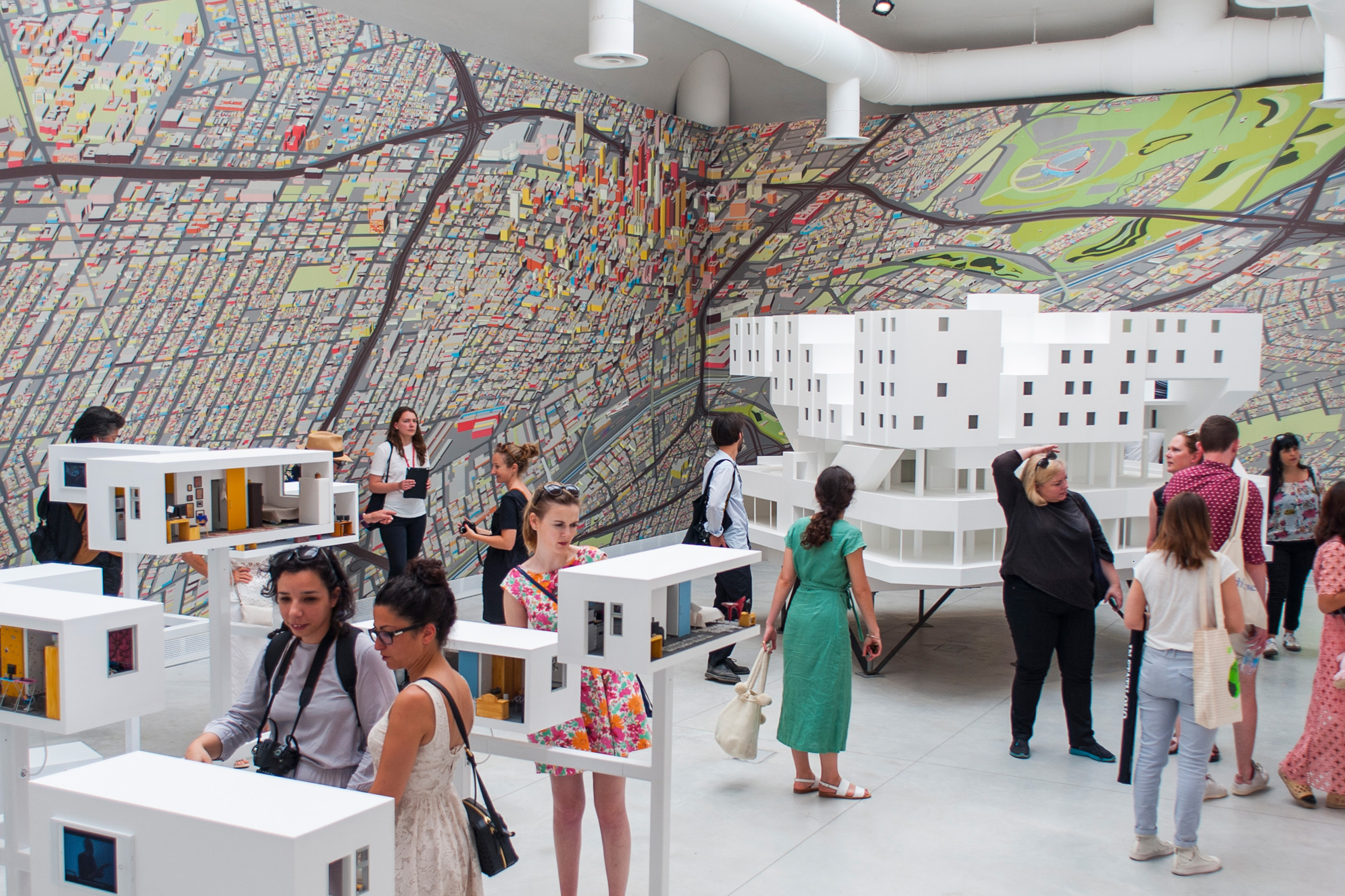05.30.2018
2018 VENICE BIENNALE IN
ARCHITECTURAL RECORD
Notes from the 2018 Venice Biennale
by Cathleen McGuigan and Beth Broome, May 30, 2018
Last Saturday, as the midday sun beat down on the rooftop terrace of Ca’ Guistinian, the Grand Canal palazzo where the Venice Biennale has its headquarters, winners of this year’s architecture awards sipped prosecco in celebration. But many of those who had attended the preview of the world’s premier architectural exposition were baffled by the jury’s choices. That the Swiss Pavilion won the Golden Lion for an installation called House Tour—a witty if one-note take on apartment hunting—was surprising enough, but more controversial was the “special mention” nod to the pavilion of Great Britain. The Brits had left their pavilion completely empty and installed a roof deck with a glorious vista of the Venetian lagoon and its islands. While the viewing platform, reached by a sturdy exterior steel stair, fit the overall Biennale theme of FreeSpace, the ironic fact was that a pavilion won an architecture award without presenting any architecture at all.
The air of Venice was heavily perfumed with honeysuckle, but the jury’s selection smelled strongly of compromise. In fact, their deliberations were said to have been as hot as the May weather, if polite. The jury included architects Sofia Von Ellrichshausen, Frank Barkow, Kate Goodwin, Patricia Patkau, and Pier Paolo Tamburelli. Regarding the honor for the British pavilion, one juror cited the relief of entering the cool, calm, empty interior amidst the cacophony of the crowded Venice Giardini, one of the main venues of the Biennale, and its many national pavilions overstuffed with images, objects, data and text. “Accessibility” and “legibility” were cited by another juror as important criteria for the Biennale, which is expected to attract a wide public before it closes November 25th. The 2016 edition of the exposition drew a record 260,000 visitors.
The jury also awarded the Golden Lion for best participant to Eduardo Souto de Moura, the Pritzker Prize–winning Portuguese architect, and the Silver Lion for a promising young participant to Jan de Vylder, Inge Vinck, and Jo Taillieu, partners in an office in Ghent, Belgium. Special mentions were given to Rahul Mehrotra of Cambridge, Mass. and Mumbai, and to Andra Martin of Jakarta. Also celebrated was Kenneth Frampton, the British-born American critic and educator whose Golden Lion for Lifetime Achievement had been announced earlier, an honor decided not by the jury but by this year’s curators of the Biennial, Yvonne Farrell and Shelley McNamara, founding partners of the Dublin firm Grafton Architects. They cited Frampton’s “extraordinary insight and intelligence combined with a unique sense of integrity.”
Completely ignored by the jury was the Vatican’s first participation in the architecture biennale, a surprise favorite of almost everyone who saw it during the preview. For the island of San Giorgio Maggiore, home to a great Palladio church and removed from the bustling main venues, the Vatican invited 11 teams to design small chapels in a quiet, leafy park. It was refreshing to see actual architecture and (mostly) well-detailed construction, integrated into nature to create serene spaces for contemplation—such as Carla Juaçaba’s elegantly minimalist steel seating and cross under a canopy of trees; Souto de Moura’s small stone chapel admitting daylight through a cross-shaped slit; Smiljan Radic’s textured concrete cylindrical sanctuary with a heavy wooden door; and Norman Foster’s wood-slatted structure, with honeysuckle beginning to climb its delicately open walls.
Further pavilions of note:
Yes, the Swiss Pavilion. Its House Tour is a plain vanilla domestic interior—bare rooms with white walls, wooden floors—that play with your sense of scale with alternating super small or super large doors, windows and other elements, as if you are Alice down the rabbit hole, but leaving you with a smile on your face.
The German Pavilion. Beginning with a close history of the Berlin Wall, this particularly well-designed exhibition, Unbuilding Walls, expands to include the experience of physical barriers and boundaries from Korea to Gaza to Northern Ireland.
U.S. Pavilion. With the theme Dimensions of Citizenship, the ambitious brief assigned seven teams to each look at the idea of belonging and exclusion at a particular scale, from the individual to the regional to the cosmos. The exhibition’s elements range from natural materials like coconut husks and cobblestones to sophisticated data maps.
Each participating country curates its own pavilion, but the Biennale’s guest curators, Farrell and McNamara, programmed the Central Pavilion in the Giardini and the nearby Arsenale, inviting dozens of architects from around the world to create installations, based on how their own projects connect to the FreeSpace theme. Here are just a few highlights:
Michael Maltzan’s Star Apartments. In a stunning installation that veers from the macro—a map of Los Angeles as gallery wallpaper—to the micro—doll-house like interiors of the personalized apartments for the formerly homeless in downtown L.A., Maltzan and his team bring to wonderful life the occupants and their stories, told through videos and the eclectic objects that define their spaces.
SANAA. On the other end of the spectrum, Seijima and Nishizawa’s installation could not be simpler—an ethereal, nearly invisible sculptural form of transparent, concentric curving walls.
Peter Zumthor. A mezzanine in the Central Pavilion holds a “workshop” of models of the master’s projects, in varying materials, from the Bruder Klaus field chapel to the as-yet-unbuilt Los Angeles County Museum of Art.
Dorte Mandrup. The Danish architect’s stunning Conditions invites viewers to imagine the extreme cold and shifting light of the Arctic north in her design for the Icefjord Center in Greenland.

